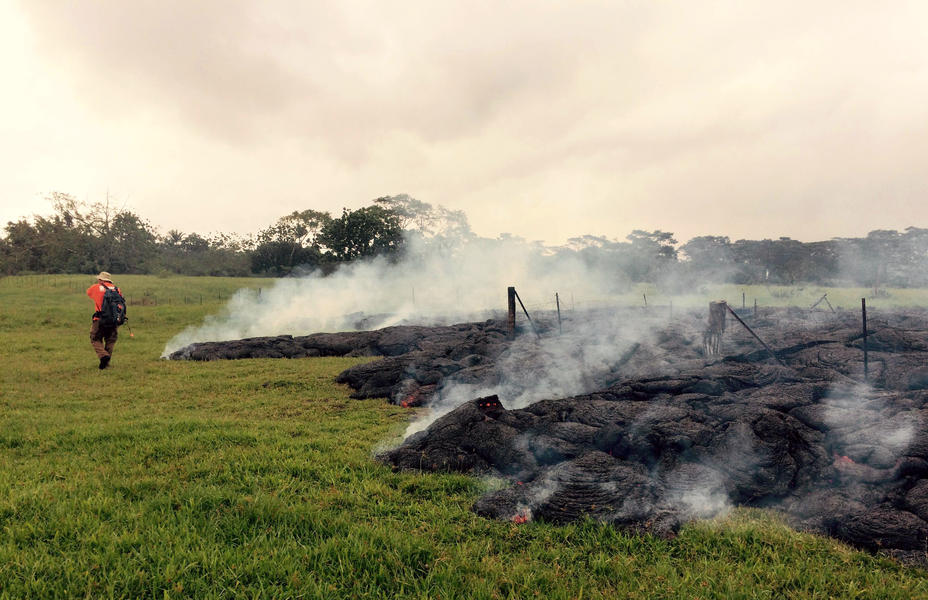Hawaii will let homeowners watch lava slowly destroy their own houses


This may be the slowest natural disaster in history: After 31 years of eruptions, a lava flow from Hawaii's Kilauea volcano that started in June has almost arrived at its first house. The slow-moving flow — anywhere from 2 to 20 yards per hour, depending on topography — has plowed over a cemetery, destroyed a shed at 7:30 a.m. on Tuesday, and will probably burn through its first house in the next day or so. About 40 to 50 houses in the Big Island village of Pahoa, some 20 miles south of Hilo, are in the path of the lava and its 2,000 degree heat.
Residents of Pahoa have been clearing the homes of prized possessions for weeks now, and many will be encouraged to evacuate soon — the main road connecting the village of 9,000 to the rest of the island is expected to be covered by molten lava some time soon. "Entire families have been raised in these homes," says Hawaii County Civil Defense Director Darryl Oliveira. "It's a very difficult thing for them to see this happening, and if we can accommodate them in any way for the grieving process, we will want to do that if it's safe."
One way of facilitating the grieving will be allowing residents to stay on their property to watch their homes being destroyed by Kilauea's molten river. "It helps a person come to grips with the reality of the situation," Oliveira says. "I found it to be oddly comforting in a really strange way." --Peter Weber
The Week
Escape your echo chamber. Get the facts behind the news, plus analysis from multiple perspectives.

Sign up for The Week's Free Newsletters
From our morning news briefing to a weekly Good News Newsletter, get the best of The Week delivered directly to your inbox.
From our morning news briefing to a weekly Good News Newsletter, get the best of The Week delivered directly to your inbox.
A free daily email with the biggest news stories of the day – and the best features from TheWeek.com
Peter has worked as a news and culture writer and editor at The Week since the site's launch in 2008. He covers politics, world affairs, religion and cultural currents. His journalism career began as a copy editor at a financial newswire and has included editorial positions at The New York Times Magazine, Facts on File, and Oregon State University.
-
 Political cartoons for January 4
Political cartoons for January 4Cartoons Sunday's political cartoons include a resolution to learn a new language, and new names in Hades and on battleships
-
 The ultimate films of 2025 by genre
The ultimate films of 2025 by genreThe Week Recommends From comedies to thrillers, documentaries to animations, 2025 featured some unforgettable film moments
-
 Political cartoons for January 3
Political cartoons for January 3Cartoons Saturday's political cartoons include citizen journalists, self-reflective AI, and Donald Trump's transparency
-
 Nobody seems surprised Wagner's Prigozhin died under suspicious circumstances
Nobody seems surprised Wagner's Prigozhin died under suspicious circumstancesSpeed Read
-
 Western mountain climbers allegedly left Pakistani porter to die on K2
Western mountain climbers allegedly left Pakistani porter to die on K2Speed Read
-
 'Circular saw blades' divide controversial Rio Grande buoys installed by Texas governor
'Circular saw blades' divide controversial Rio Grande buoys installed by Texas governorSpeed Read
-
 Los Angeles city workers stage 1-day walkout over labor conditions
Los Angeles city workers stage 1-day walkout over labor conditionsSpeed Read
-
 Mega Millions jackpot climbs to an estimated $1.55 billion
Mega Millions jackpot climbs to an estimated $1.55 billionSpeed Read
-
 Bangladesh dealing with worst dengue fever outbreak on record
Bangladesh dealing with worst dengue fever outbreak on recordSpeed Read
-
 Glacial outburst flooding in Juneau destroys homes
Glacial outburst flooding in Juneau destroys homesSpeed Read
-
 Scotland seeking 'monster hunters' to search for fabled Loch Ness creature
Scotland seeking 'monster hunters' to search for fabled Loch Ness creatureSpeed Read
